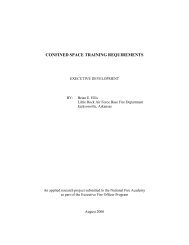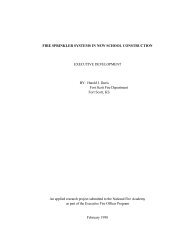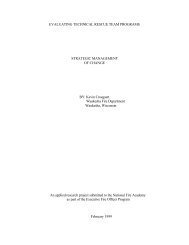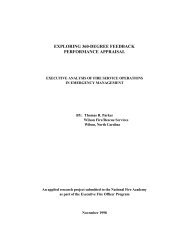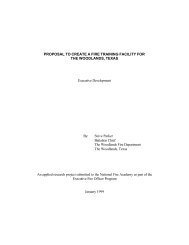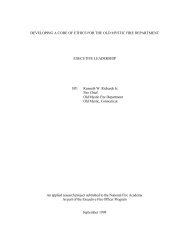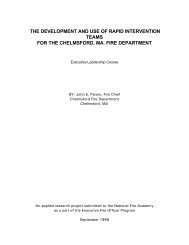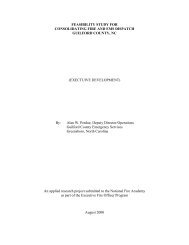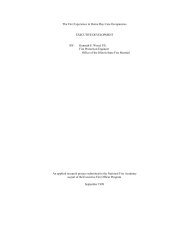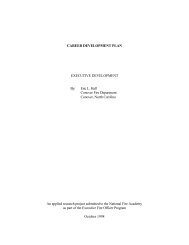Value Statements - US Fire Administration
Value Statements - US Fire Administration
Value Statements - US Fire Administration
You also want an ePaper? Increase the reach of your titles
YUMPU automatically turns print PDFs into web optimized ePapers that Google loves.
Format changes have been made to facilitate reproduction. While these research projects have been selected as<br />
outstanding, other NFA EFOP and APA format, style, and procedural issues may exist.<br />
values defines what the activities and results "should be." Second, organizational culture is<br />
articulated in value statements. Defining organizational culture assists employees as they arrive<br />
at shared goals and expectations. Third, they motivate and inspire members to a sense of<br />
commitment that contributes to improving organizational performance (Ledford et al., 1995) and<br />
thereby assist employees in the uncharted areas of decision making (Amuso and Giblin, 1997).<br />
Written value statements can also guide behavior in the workplace (Lebow and Simon,<br />
1997). Amuso and Giblin (1997) reinforce this concept by stating that there is a direct<br />
correlation between strong positive cultures and written organizational values. Faced with a<br />
choice or dilemma, an effective value statement gives people a way to decide, every day<br />
(Stewart, 1996a).<br />
Moreover, principles that outline a required standard of conduct are embodied in value<br />
statements (Navran, 1997) and thereby establish a standard by which members can hold one<br />
another accountable (Dion, 1996). <strong>Value</strong> statements state what is expected and serve as a<br />
benchmark for judging individual behavior and organizational decision-making (Strickland and<br />
Thompson, 1996). Decisions and behavior are evaluated against this standard to determine if<br />
they are congruent with organizational and employee standards (Navran) which consequently<br />
establish the foundation for self-governance and the capacity for autonomous activity<br />
(Berenbeim, 1995).<br />
Research Question 3 Overall, 67 percent of the respondents indicated they had<br />
conducted a formal values audit process to identify their respective departmental values and,<br />
additionally, had generated organizational value statements from that data (See Appendix D).<br />
The literature revealed that there were three germane developmental methodology<br />
questions pertaining to value statements. The first question was, "What organizational member<br />
or group developed your Department's value statements" Survey respondents indicated only<br />
two of the four possible alternatives were utilized to develop value statements. Forty-seven<br />
percent of departments surveyed utilized a labor management group methodology to develop<br />
value statements. The second most common developmental methodology, 20 percent, utilized to<br />
create value statements was administrative staff personnel. Two organizations used a<br />
combination of both methodologies.<br />
The second question was, "What methodology was utilized to develop the language for<br />
your Department's value statements" The survey data shows there were two methodologies<br />
utilized to develop value statement phraseology. The most common methodology employed by<br />
40 percent of organizations surveyed was a combination of starting from scratch and massaging<br />
the verbiage from other organizations value statements. However, 27 percent of surveyed<br />
departments started from scratch to create the language of their value statements.<br />
The third question was, "What methodology was utilized to disseminate value statement<br />
information to field personnel" Again, respondents indicated only two methods were used in<br />
disseminating value statement information to field personnel. Every organization that created<br />
value statements utilized written mission, values, or value statement documents to communicate<br />
the information to field personnel. The second most common methodology applied was verbal<br />
- 176 -





